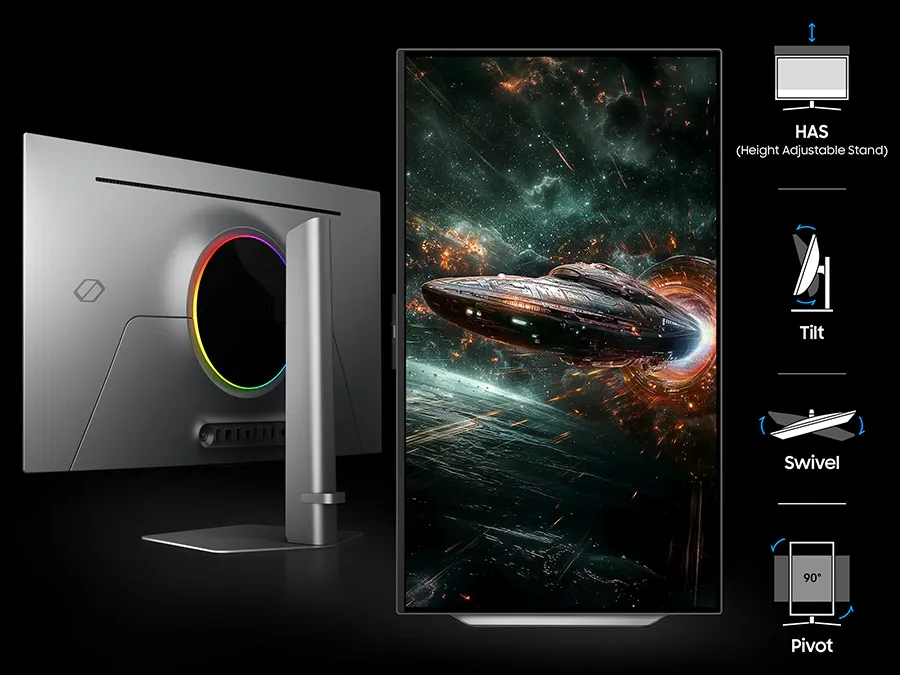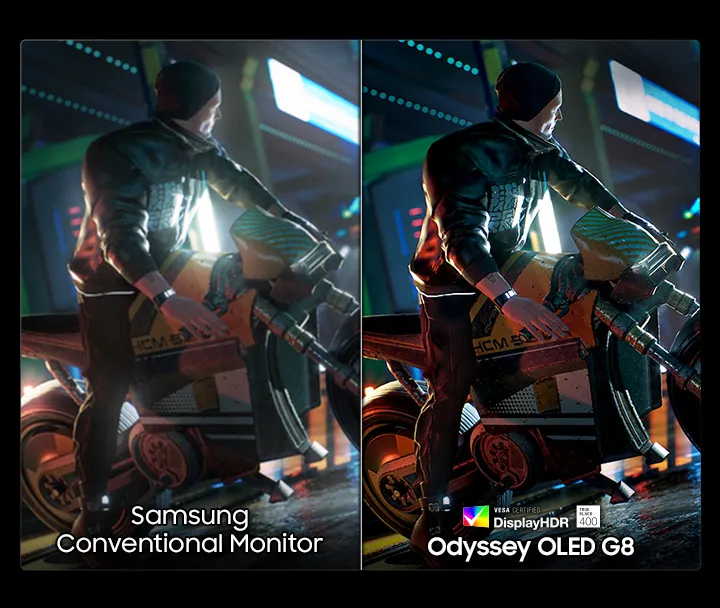Thanks to Samsung, I recently had the opportunity to use their 27″ Odyssey OLED G8 G81SF 4K 240Hz Gaming Monitor, which came out earlier this year, as part of my office setup for a couple of months. I’ve been using Samsung monitors for almost my entire gaming/PC using life, so I was excited to see what this one had to offer.
The Odyssey OLED G8 comes standard with most things you expect from a monitor these days: the ability to rotate the screen to a vertical setting, cable management, ability to tilt the screen. It features two HDMI ports and a Display Port, though this being 1.4 and not 2.1 has been a topic for debate. While it doesn’t have built-in speakers, it does feature a headphone jack.
The base plate is a solid metal, creating a heavy but sturdy base to the monitor, with the silver colour continuing to frame the monitor. I personally like my monitors white to match my room’s aesthetic, but it doesn’t look bad. The monitor comes in both a 27″ and a 32″ size. I typically use a 32″ for my main monitor, so it took a little getting used to using the 27″, especially with the 4k resolution making everything on my screen look tiny.

One of the main selling points of the Odyssey OLED G8 is its reactive RGB backlight. This isn’t active right out of the box, and was honestly a bit difficult to actually figure out how to turn on. The navigation of the menu wasn’t very intuitive, and the setting is not exactly named how you might think. The reactive lighting is designed to utilise the screen colours while playing video games, to extend the visuals past the screen and enhance the gaming experience. Personally, by the end of my time with the Odyssey OLED G8 monitor, I had almost forgotten this was a feature because it just wasn’t all that noticeable, unless I was playing in the dark, and even then, it wasn’t super noticeable for me. A cool feature if you like RGB lights, but it felt a little gimmicky and not bold enough to fully enjoy.
The monitor features a dynamic cooling system, with an internal coolant pipe able to diffuse heat five times faster than a graphite sheet, to help prevent burn-ins and overheating. It also automatically reduces the brightness of static images such as logos and the taskbar to further prevent burn-ins, as well as having a 10 minute inactivity dimmer, so if you step away from your PC for any reason, you don’t need to stress about that one webpage you get stuck on for several hours burning into the screen forever.

My favourite part of the monitor is the glare-free screen, which isn’t necessarily everyone’s cup of tea, but it’s definitely mine. My desk is positioned right next to a huge window, and usually I can’t both enjoy the sunlight and play video games at the same time. With the Odyssey OLED G8’s glare-free screen, I could have my blinds fully open and comfortably enjoy using my computer with no issues. This was also very helpful as I have an astigmatism, which means light reflects weirdly in my eyes, and it can make looking at a screen (especially a glossy one) for a long time quite painful. I didn’t once feel like this with the glare-free screen, and it was very enjoyable.
Of course, the actual OLED display itself looked great, featuring VESA DisplayHDR TrueBlack 400, which is just a fancy way of saying shadows were extra deep, helping to ensure colours really popped. This, partnered with a 240Hz refresh rate and 0.03ms response time, makes for very smooth gaming. I had a few minor issues while using the monitor, which might be chalked up to simple compatibility issues with my other, cheaper monitor not liking the change in resolution, as well as frame drops while watching YouTube videos. Apparently, this is common for 4k monitors, so don’t let that deter you if you’re liking the sound of this one, but just something to be aware of.
“…shadows were extra deep, helping to ensure colours really popped.”
During my time with the monitor, I was focused primarily on playing and reviewing two games: Titan Quest 2 on PC and Grounded 2 on my Xbox. Titan Quest 2 is a fast-paced ARPG with lots of creative enemy design and vivid colours both in the world and in your abilities and attacks. Playing with the Odyssey OLED G8 made this experience quite enjoyable, thanks to both the glare-free screen (as I played a lot of this during the daytime) and the high refresh rate and response time, meaning that attacks or quick action never looked slow or like anything was lagging. The colours were nice, though I did need to decrease my saturation on the monitor a little bit, but once I had the settings how I liked them, everything was great. Titan Quest 2 has areas of the game that are bathed in warm sunlight, and visually, these were my favourite parts of the game. The colours really popped and you could almost feel the heat of the sun beaming down on your hero.
Grounded 2 also looked great, but for different reasons. A lot of my time with Grounded 2 was spent in the dark, down in deep ant hills or running around at night time trying not to get eaten by any number of dangerous bugs out to get me. Though Grounded 2 is also a very colourful game, full of bright greens and reds, and the bright blue of the daytime sky, it was also a way for me to truly get a sense of the VESA DisplayHDR TrueBlack 400, as the shadows and darker areas of the game really felt like I was in places I shouldn’t have been, especially when my torch died. Instead of being able to vaguely see in a grey-washed area, it felt like an inky blackness where I was really in over my head. I never saw that O.R.C. Weaver coming, literally…
While the Odyssey OLED G8 is sturdy and sleek, with a crisp image and glare-free screen, I just personally couldn’t justify the price. I’m not a highly competitive FPS gamer, and some of the compatibility issues with my second monitor made it hard to enjoy sometimes. Even currently on sale, down to $1200 (from its original $1800 price tag), it’s nearly triple what I paid for my curved Samsung monitor that I’ve come to love and have used for years. If you’re looking for a 4k monitor that has some great specs, this is definitely not a bad choice. It just didn’t feel all that special to me, especially with 4k monitors becoming more accessible and more affordable, some decent ones only costing around $500 or less. Though I might have to start shopping around for a glare-free screen…
A loan unit of the 27″ Odyssey OLED G8 G81SF 4K 240Hz Gaming Monitor was provided by Samsung Australia for the purpose of the coverage.





